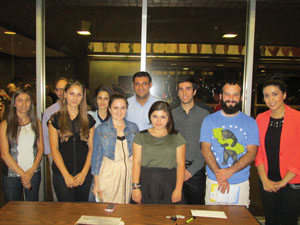Suren Oganessian
Staff Writer

Photo: Barlow Der Mugrdechian
One little-discussed aspect of the Armenian Genocide was addressed when historian Ümit Kurt visited Fresno State on September 17 to speak on “The Emergence of the New Wealthy Class between 1915-1922: The Seizure of Armenian Property by the Local Elites in Aintab” as part of the Armenian Studies Program Fall Lecture Series; what happened to Armenian properties after the Armenians were massacred and deported? Mr. Kurt has dedicated himself to finding out.
Part of a small but growing pool of Turkish scholars who not only admit the Genocide occurred but study it, Kurt is a PhD candidate in the Department of History at Clark University in Worcester, Massachusetts, and an instructor at Sabanc? University in Istanbul. A native of Aintab, situated in South-Eastern Turkey, north of Aleppo and within the boundaries of what was once Cilicia, Kurt first became interested in the city’s hidden Armenian past when visiting a coffee shop with a friend in the former Armenian quarter, and learning that before 1915, Armenians had dwelt there. Determined to dig deeper, Kurt perused the Ottoman archives and other local historical sources and was able to piece together a sordid tale, a microcosmic representation of what was happening all over Turkey at the time.
The Genocide of the Armenians was administered and overseen by the Committee of Union and Progress Party, and taken to the local level by corrupt government officials who were promised portions of the “abandoned properties” of deported and murdered Armenians. By claiming that the properties were abandoned, the Ottoman government sought to legalize the murder and plunder of the Armenians. With money and property as an incentive, and nationalism and the creation of a “racially pure Turkish state” as a justification, the Armenians in Aintab were systematically deported, in phases.
On July 13, 1915, the orders came from the Young Turk government to deport just the Apostolic Armenians; the Catholic Armenians would be next, deported on September 19. The Protestant Armenians were under the protection of American missionaries for a time, but on December 19, they too were deported into the Syrian desert. In their absence, the Armenian quarter became a bazaar where their belongings and properties were auctioned off, local authorities claiming the bulk of the wealth. The Ottoman Bank bought up properties at a fifth of their actual value. Through the act of Genocide, a new Turkish wealthy class emerged in Aintab and across Turkey.
A fraction of the deported Armenians returned in 1918 when France came to occupy the area following the end of World War I; only to be forced to leave with the retreating French troops shortly thereafter. By 1922, Aintab’s 30,000 Armenians had vanished. But, signs of their presence in the city haven’t vanished completely. Kurt was able to find over 200 locations in the city that were former Armenian properties, and at his lecture displayed photographs of the buildings of the former Armenian quarter, now occupied by Turks, as well as the St. Mary Armenian Church, which was converted into a mosque.
In all, the lecture was remarkably well-received by its audience, as hearing someone of Turkish descent speak about the topic of the Genocide is a rare opportunity. When asked whether or not the Turkish government has interfered at all with his research, Mr. Kurt denied it, suggesting that the Turkish government has softened its enforcement of Article 301 against insulting Turkishness due to the bad publicity it gives the country.
Thus, discussion of the Genocide has increased in scholarly circles, with Ümit Kurt at the forefront of the movement. As more scholars such as Kurt come forth, perhaps one day they can be part of the solution, to help Turkey come to terms with the Genocide so that Armenians and Turks can once more live together in peace.
 Hye Sharzhoom Armenian Action
Hye Sharzhoom Armenian Action